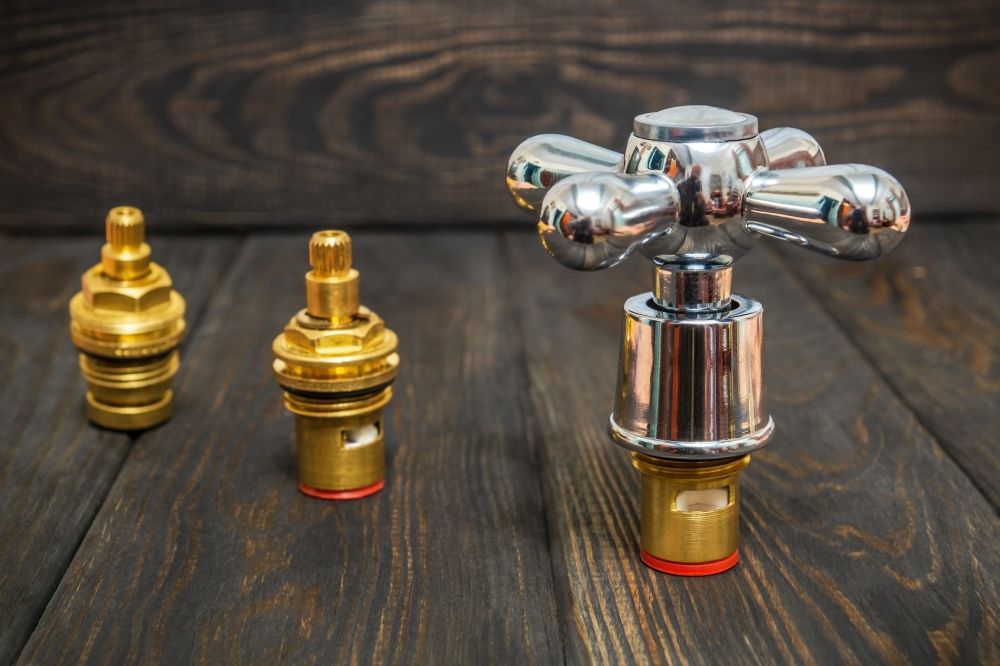
[Image above] Ceramic disc valves, seen through the slit in the brass disc cartridge, are considered the longest lasting and most leakproof type of faucet valve currently available. Credit: Vitalii Borkovskyi, iStock
Constant handwashing is an unforgettable feature of the early COVID-19 pandemic days. But despite all that time spent scrubbing up over the sink, you may not have spared a thought for the faucet responsible for delivering water on command.
In today’s CTT, we will tap into the unsung history of faucets and plumbing systems, which despite their modest nature, are a prime example of how hidden ceramics enable the amenities taken for granted in today’s world.
Plumbing through the ages
Running water at the twist of a lever is a convenience with a much longer history than you might imagine, dating back to the Harappans more than 5,000 years ago. In these early days, water distribution systems were commonly used for crop irrigation and ceremonial spaces. But as agricultural practices drove the growth of cities, sewerage and drainage systems to handle human waste became a common application of plumbing infrastructure.
Indoor plumbing declined in the Middle Ages as the population spread out from the cities, but demand increased in the 18th and 19th centuries as industrialization spread. Precipitous population increases highlighted the urgency of improving sanitation, with deadly cholera and typhoid outbreaks common in Manchester, England, by the early 1800s. In response, cities installed cast iron water mains and sewage systems to service residential and commercial buildings.
Terracotta was the material of choice for pipes and plumbing fixtures for millennia. However, metals eventually became the preferred material for pipes and faucets due to their superior durability and malleability, which made them easy to shape.
The mass production of metal piping in the late 19th century allowed indoor plumbing to became a standard fixture in most homes. But, not in all homes—more than half a million U.S. households today experience plumbing poverty, i.e., a lack of running water and/or an indoor bathing area.
Though metal is now the preferred choice for pipes, ceramics remain a popular choice for plumbing fixtures such as sink basins and toilets, as evidenced in popular culture by artists such as Marcel Duchamp. They also play a critical but hidden role within metal-bodied faucets, as revealed in the section below.
Evolution of faucet technology
In the early days of indoor running water (as far back as the Roman Empire), a single faucet with a rudimentary plug valve system delivered hot or cold water through separate lead pipes. This system was common in public bathhouses but only found in the homes of wealthy individuals.
Plug valve faucet systems consist of cylindrical or conically tapered “plugs” (obstructing objects) inside the valve body, with a hole in one side of the plug. A quarter turn of the plug aligns the hole with the pipe, allowing water to flow.
Plug valves do not offer much control over the water flow. Compression valves, on the other hand, operate more like a screw, allowing the valve to open or close incrementally. These valves, which were invented in the mid-1800s, offer much finer control of the flow of water.
Compression valve faucet systems originally required separate faucets for cold and hot water, just like the earlier plug valve faucet systems (if you were fortunate enough to have a water heater). But in 1880, a Canadian named Thomas Campbell devised a faucet with a single outlet that could internally mix the outputs from the pipes carrying hot and cold water. The faucet had a wider outlet than either of the service lines to compensate for back pressure.
Campbell’s mixing faucet still required separate handles for hot and cold water. In the mid-1900s, though, two new “washerless” faucet systems were invented independently, allowing temperature control with a single handle.
The first system was developed by Alfred “Al” Moen. In 1937, Moen burned his hands under a two-handle hot water faucet, and he spent the next decade creating a brass washerless cartridge valve that enables mixing of hot and cold water using a single handle. This invention led to the creation of Moen Inc., which today is one of the major producers of plumbing products in the U.S.
The second system was developed by Landis Perry. His system is similar to Moen’s, but it uses a ball-shaped rather than cylinder-shaped valve, which allows the system to be smaller and have fewer parts. These differences allowed Perry to patent and sell the design to Delta Faucet Company in 1952 (the first single-handle faucet using the Moen valve was introduced in 1947).
That brings us to the most recent development in faucet technology, the ceramic disc valve. This system, which was granted a patent in 1973, consists of two ceramic discs that rotate against each other to align holes in each disc. When aligned, water flows freely.
Ceramic disc valves offer several advantages compared to other valve designs. First, unlike metal, ceramic does not expand or contract in response to water temperature and is resistant to corrosion. This stability prevents cracking and reduces wear on the parts. When ceramic disc valves do wear out, their simple construction of rotating discs in a metal frame—with no springs or washers—makes them much easier to repair or replace.
Furthermore, the rotating ceramic disc enables precise water flow control with tight seals, so that less water is wasted. As water becomes an increasingly scarce resource, water conservation becomes an increasingly important factor in faucet design.
What’s on tap for the future
In some ways, modern sink and faucet design has come full circle back to the aesthetic of the washstand that held a pitcher and basin. Today’s ceramic basin sinks recall those functional pieces of furniture that were common features in bedrooms well into the early 20th century, before running water in homes really took off.
Now that faucet valves are largely optimized for precise water temperature and flow control, it makes sense that incorporating smart technology would be the next big step in faucet design. Hands-free operation and temperature settings make faucets safer and easier to use for everyone from young children to people with mobility issues. Smart faucets have additional health benefits, such as reducing risks of germ transmission associated with touching the knobs.
Closed-loop supply chains for faucets are another area ripe for innovation. As engineers, architects, and designers begin to think more carefully about sustainable design, the importance of such manufacturing pathways will increase.
Of course, while function is certainly important, sometimes the aesthetic is top priority for designers. For example, faucets and knobs made of blown glass offer a unique look for discerning consumers. (I have about as much proprioception as a bull in a china shop, however, so although these faucets are beautiful, they would be impractical in my house.)
The next time you wash your hands, spare a thought for the ceramics, from terracotta pipes to ceramic disc valves, that have made the luxury of indoor plumbing possible from ancient times until today.
Author
Becky Stewart
CTT Categories
- Construction


